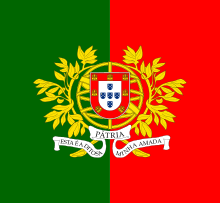Portuguese Marine Corps
The Portuguese Marine Corps (Portuguese: Corpo de Fuzileiros, meaning literally "Corps of Fusiliers") are an elite infantry and special forces unit of the Portuguese Navy, It has similar roles to the American Marine Recon and Royal Marine Commandos. The Corps is specialised in amphibious warfare, coastal reconnaissance, unconventional warfare, guerrilla warfare, raids, maritime interdiction and boarding operations. It is an elite light infantry force, operating as a rapid-reaction force.
| Portuguese Marine Corps | |
|---|---|
| Corpo de Fuzileiros | |
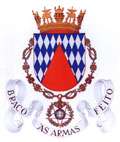 Coat of arms of the Portuguese Marine Corps | |
| Founded | 1618 |
| Country | |
| Branch | |
| Type | Marines |
| Role | Amphibious warfare Special operations |
| Garrison/HQ | Lisbon Naval Base |
| Nickname(s) | Fuzos |
| Patron | St. George |
| Motto(s) | Braço às armas feito ("An arm to Arms addrest", from Os Lusíadas, Canto X, 155, v. 1) |
History
The Portuguese Marines (Portuguese: Fuzileiros) have their direct origin in the oldest permanent military unit of Portugal, the Regiment of the Navy of the Crown of Portugal (Terço da Armada da Coroa de Portugal), created in 1618. However, since 1585, specialized troops existed to provide artillery and riflemen in the Portuguese warships. The Regiment of the Navy was soon considered an elite unit. As the King of Portugal did not have a royal guard (only the ceremonial Royal Guard of the Halberdiers), this Regiment was also used in the role of bodyguard of the Monarchs.
In the 18th century, a second regiment of naval infantry was created. In 1791, a Regiment of Naval Artillery was added to the force.
In 1797, in the reign of Queen Maria I, all the regiments of the Navy were merged and integrated into the new Royal Brigade of the Navy (Brigada Real da Marinha), which included three divisions: Fusiliers (fuzileiros), Artillerymen (artilheiros) and Artificers (artifices e lastradores). In 1807, the Brigade was reorganized, going to be made of three battalions, all of them of Artillerymen.
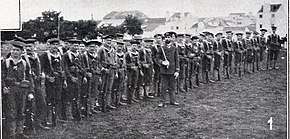
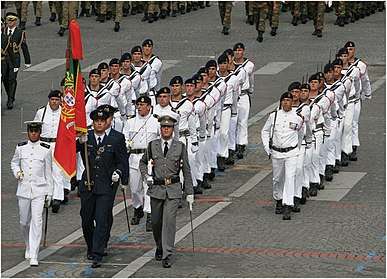
.jpg)
In 1808, the Army of Napoleon invaded and occupied Portugal. In order not to be captured and, so, to maintain secure the Portuguese sovereignty, the Royal Family and most of the Court relocated to the Portuguese colony of Brazil, on board of the Portuguese fleet and accompanied by the majority of the Royal Brigade of the Navy. This contingent of the Brigade continued to remain in Brazil, even after its independence in 1822, given origin to what is now the Brazilian Marine Corps. In 1809, a force of the Brigade in Brazil participated in the Portuguese conquest of French Guiana.
With most of the original force of the Brigade remaining in Brazil, in 1822 it started to be reconstituted in Portugal. In 1823, it was organized in two battalions.
During the Portuguese Civil War (1828-1834), the Royal Brigade of the Navy aligned on the side of the Miguelite forces. On the opposite side however, the Liberals created a Battalion of the Navy (Batalhão de Marinha). In 1832, the Liberal Battalion of the Navy was augmented and transformed in a Regiment (Regimento da Armada) with four battalions.
In 1836, already after the end of the Civil War, the Royal Brigade of the Navy was extinguished. It was replaced by the new Naval Battalion (Batalhão Naval) created in 1837.
In each of the ships' crews of the Portuguese Navy, only the officers and the members of the embarked detachments of the Naval Battalion (and previously of the former Royal Brigade of the Navy) were military personnel, with the sailors being civilians. The different status of the several parts of the crews always created issues.
In 1851, the decision was taken to militarize the sailors, with the creation of the Corps of Military Seamen (Corpo de Marinheiros Militares). This Corps started to be responsible for the providing of the ships' crews. It was organized in 22 crew companies, each one subdivided in two half-companies, plus a depot company. Each of these companies and half companies was intended to constitute the crew of a ship, in rotation. All seamen of the Corps received a general training that included seamanship, artillery, infantry, bladed weapon combat, boarding and amphibious landing. In each company, a number of seamen received an advanced training in naval artillery, constituting its squad or artillerymen. This military training meant that the seamen were able to assume the responsibility to perform also the role of naval infantry when needed, what made unnecessary the existence of the Naval Battalion, which was then dissolved.
From this date, whenever there was a need to perform an amphibious operation, landing detachments were constituted with seamen taken from the ships' crews. For the colonial campaigns of the late 19th and early 20th centuries and for the World War I, larger naval infantry forces and naval battalions were organized in the Corps of Seamen itself.
In 1924, a permanent unit of naval infantry was again created, this being the new Brigade of the Naval Guard (Brigada da Guarda Naval). However, it ceased to exist in 1934, with the role of naval infantry being again entirely assumed by the regular seamen when needed.
The naval infantry only reappeared as permanent force in 1961, with the beginning of the Colonial War. Besides the Marines School (Escola de Fuzileiros), two types of operational marine units were created at that time, these being the detachments of special marines (DFE, destacamentos de fuzileiros especiais) and the companies of marines (CF, companhias de fuzileiros). While the DFE were designed to operate as amphibious assault units, the CF were focused in the naval patrolling and in the defense of naval ships and facilities. During this war, and up to 1975, more than 14,000 marines fought in Portuguese Guinea, Angola and Mozambique.
Until 1975, a unified Marine Corps Command did not exist, with the diverse DFE and CF being separate units, depending from the several naval and maritime defense commands of the areas where they operated. In this year, the Marine Corps (Corpo de Fuzileiros) was created, unifying all marine units under a single command.
Organization
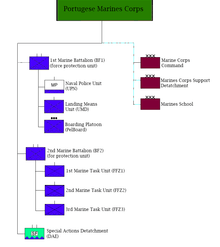

Since 2015, the Portuguese Marines Corps includes:
- Marines Corps Command;
- Marines Corps support departments (Administrative and Financial, Operations, Resources Management and General Support);
- Marines School - training unit;
- 1st Marine Battalion (BF1) - force protection unit. Includes:
- Naval Police Unit (UPN),
- Landing Means Unit (UMD),
- Boarding Platoon (PelBoard);
- 2nd Marine Battalion (BF2) - force projection unit. Includes three permanent Marine forces:
- 1st Marine Task Unit (FFZ1),
- 2nd Marine Task Unit (FFZ2),
- 3rd Marine Task Unit (FFZ3);
- Special Actions Detachment (DAE) - special operations unit. Constitutes a special operations maritime task group, with three special operations task units.
The permanent task units of the BF2 are designed to conduct raids and other small scale amphibious operations. To conduct larger scale amphibious operations, the Marine Corps can organize a temporary battalion landing team (Batalhão Ligeiro de Desembarque), based on the BF2, reinforced with additional means from the other Marine units and from the General Support Department of the Marines Corps.
The Marine Corps elements are based in the Vale do Zebro facilities (Marines School) and the Alfeite facilities (former Marines Base).
Training
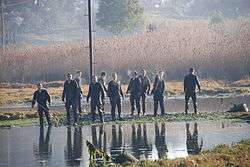
Initial training to become an enlisted Fuzileiro (marine) lasts about 42 weeks. The training is conducted at the Marines School (Escola de Fuzileiros) in Vale de Zebro. It is physically and mentally rigorous and demanding, with only 15% to 35% of the initial trainees passing and becoming Fuzileiros.
The recruits in training are constantly under stress and pressure from instructors leaving them no respite. All activities are timed and scored: marching several tens of kilometers with equipment and weapon, land and mud obstacle courses, navigation at night on the ground. The training is punctuated by firearms training and special combat techniques, rappelling and climbing, boating, basic demolitions, communications and hand-to-hand combat.
The later stages of the course are mostly field based exercises mimicking real operations within land and amphibious theaters. This last phase puts into test what was thaught and practiced in the initial stages like reconnaissance patrols, assault raids, ambushes, CQB/urban operations, SERE, NBC warfare and so on...
The course culminates in a 60 km group march which must be completed in a set time.
After completing their training with success, the Fuzileiros receive the dark blue beret and the course badge on an official ceremony before being assigned to operational units.
Equipment
.jpg)
Light weapons:
- Glock 17 9mm pistol;
- Sig P226 9mm pistol;
- MP5 9mm submachine gun;
- MPK 9mm submachine gun;
- G3 7.62mm assault rifle;
- G36 5.56 mm assault rifle
- HK417 7.62mm assault rifle and sniper variant;
- M4 Carbine and M203 40mm grenade launcher ;
- Remington 870 12gauge shotgun;
- Mossberg 590 12gauge shotgun;
- Benelli M3 12gauge shotgun;
- Benelli M4 12gauge shotgun;
- SPAS 15 12gauge shotgun;
- MSG-90 7.62mm sniper rifle;
- AWSM .338 LM sniper rifle ;
- AW 7.62mm sniper rifle
- AW50 12.7mm sniper rifle;
- MG3 7.62mm general purpose machine gun ;
- MG4 5.56mm light machine gun;
and more.
Mortars:
- 120mm heavy mortar;
- 81mm medium mortar;
- 60mm fast mortar;
Anti-Tank/Anti-Aircraft weapons:
Amphibians:
- LDM100 Class Landing craft ;
- LDM400 Class Landing craft;
- Zebro class inflatable boat;
Vehicles
- Traxter HD8
- Nissan Patrol
- Land Rover Defender 90
- Toyota Land Cruiser HZJ73 armed with MILAN, M2 Browning or HK GMG
- Mitsubishi L200
- Mercedes-Benz 24 GD
- Mercedes-Benz Unimog U1300L
- Mercedes-Benz Unimog U1550L
- Mercedes-Benz Unimog U4000
- Mercedes-Benz Atego 1823
- Mercedes-Benz Actros 3340 EMPL Fahrzeugwerk EH/TC 30.000
- Iveco Trakker 330 with communications shelter
- LARC-V
See also
- Portuguese Navy
- Special Actions Detachment
- Sapper Divers Detachments
- List of Portuguese naval ships
- Portuguese Naval Aviation
- Portuguese Colonial War
